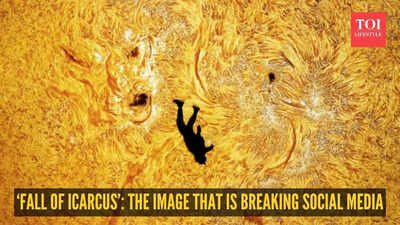 They named the image The Fall of Icarus, and the reference is intentional: a human silhouette caught in a moment that looks equal parts daring and mythic. But this isn’t myth, it’s a precision photograph born of months of planning, specialised solar kit and split-second timing. The result is a single-frame illusion: a skydiver’s dark outline perfectly mapped against the Sun’s turbulent chromosphere, rendered in hydrogen-alpha light.
They named the image The Fall of Icarus, and the reference is intentional: a human silhouette caught in a moment that looks equal parts daring and mythic. But this isn’t myth, it’s a precision photograph born of months of planning, specialised solar kit and split-second timing. The result is a single-frame illusion: a skydiver’s dark outline perfectly mapped against the Sun’s turbulent chromosphere, rendered in hydrogen-alpha light.
How they pulled it off
Astrophotographer Andrew McCarthy set up specialised solar equipment on the ground while skydiver Gabriel C. Brown jumped from a small aircraft. McCarthy told IFLScience the idea evolved over months after a skydive: “Gabe and I met up to skydive a few months ago, and afterwards we had breakfast and were talking about how we could incorporate skydiving into astrophotography. This idea slowly evolved from there, to take a paramotor to altitude and have him jump while I got the shot.” The successful capture required real-time coordination between McCarthy, Brown and the pilot.
The technical side: Hydrogen-alpha and tight framing
McCarthy used hydrogen-alpha imaging to reveal the Sun’s chromosphere, the thin, roiling layer just above the photosphere, so the solar surface shows filaments, prominences and active regions. The field of view for that kind of solar imaging is extremely narrow, which is why alignment mattered: McCarthy explained the logistics to IFLScience. “This was quite tricky! I set up several cameras and got on a 3-way call with the pilot and Gabe.The pilot watched his shadow as he climbed in the aircraft, and when he saw it was going to intersect where I was set up, he would idle his power and glide through the Sun, while I gave commands on how to steer once I could see his silhouette,” he said. “It took six attempts at this before finally lining the jumper up with the sunspots, when I used the command to jump.”According to the report, the jump occurred on 8 November 2025 from roughly 3,500 ft while McCarthy shot from about 8,000 ft away; a single successful exposure, timed within the narrow window before the parachute had to be repacked, produced the final print. The coordination was complicated by equipment malfunctions and the tiny margin for error inherent to solar tracking and human freefall. The kit used (a Lunt 60mm H-alpha telescope and ASI camera) and McCarthy’s practice of stacking exposures to preserve solar detail while freezing the jumper’s silhouette.
The image and its reaction
Seen in close-up, the skydiver’s silhouette aligns so neatly with active regions and sunspots that the photograph reads like deliberate choreography. McCarthy called the planning “an absolutely preposterous level of planning” and suggested the shot “might be the first photo of its kind in existence,” comments repeated in several outlets. The image has been shared across social platforms (McCarthy and Brown posted it on Instagram). One user said, “Insanely epic. You’re pushing the boundaries of what astrophotography can be. I love it dude.”Another said, “This is why we need to keep supporting real human made art. this is fucking beautiful!”Third said, “I always wonder if you’ll run out of ideas after having done so many amazing photos, and then you do something like this. Bravo.”McCarthy himself has a track record of transit and solar work (including ISS and rocket transits), and this image extends that practice into a more theatrical, human element, a reminder that astrophotography increasingly sits at the intersection of technical skill, patient planning and bold concept.

